If you got to choose a climate you wish to live in for the rest of your life, what would it be? Do you know there are destinations that have great weather all year round?
Discover which places in Europe have mild sunny winters, warm summers, and just enough rain to keep nature around green and lush.
Secure Peace of Mind with Best-Value International Health Coverage
International Citizens Insurance provide free, no-obligation quotes from the leading international health insurance providers with plans tailored to meet your needs. Trusted by thousands of expats worldwide.
What's your ideal climate?
Most people would probably dismiss their favorite holiday weather because holidaying on a hot sandy beach for two weeks is not the same as living there all year round. The ideal location for the majority of people would be:
- Never too hot and never too cold (about 22-23°C all year round);
- Just enough rain to keep hills and forests green;
- No hurricanes, storms, tsunamis, hails or other annoying weather extremes;
- A soft breeze to keep the air fresh;
- The densest ozone layer above protects from the sun’s ultraviolet radiation;
- And an occasional cloud to provide shelter from direct sunlight when there is too much of it.
There is a reason why most of us would name such weather conditions ideal.
Climates that are sunny, warm, and free from extreme weather all year round can be hugely beneficial for our health. They boost our positive emotions and fitness, help regulate our sleep and body weight, and generally make us happier people.
On the whole, this is a pretty good description of the healthiest climate for humans.
The advantages of living in a constant “sunny and +23°C” climate are impossible to overestimate.
Unfortunately, nowhere on our planet can match the ideal climate we have depicted above.
However, there are a few blessed places around the world that do have moderate sunny and warm weather all year round.
If you live in Costa Rica in the Central Valley, for example, you can enjoy year-round average daily temperatures between 22 and 24°C degrees, with summer highs rarely touching 29°C and winter lows often hovering at a quite bearable 18°C.
Another destination is the Loja Valley in Ecuador, which has daily averages of around 22-23°C pretty much all year long.
If you choose to live in Mexico, there are also some amazing locations with great weather all year round.
However, what if we feel reluctant to put too big a distance between dear old Blighty and our new home? Is there anywhere we can go in old-fashioned Europe to find paradise-like weather that lasts all year round?
As it happens, there are actually places in Europe with a climate very close to the ideal sunny and +23°C all-year-round weather.
Here are five European destinations with great weather almost all year round:
1. Sassari, Sardinia, Italy
Sardinia, a fabulous island in the middle of the western Mediterranean, boasts a wonderful climate. In summer, the temperature is hot but not too hot and humid, and the sun is out almost consistently from May to November.
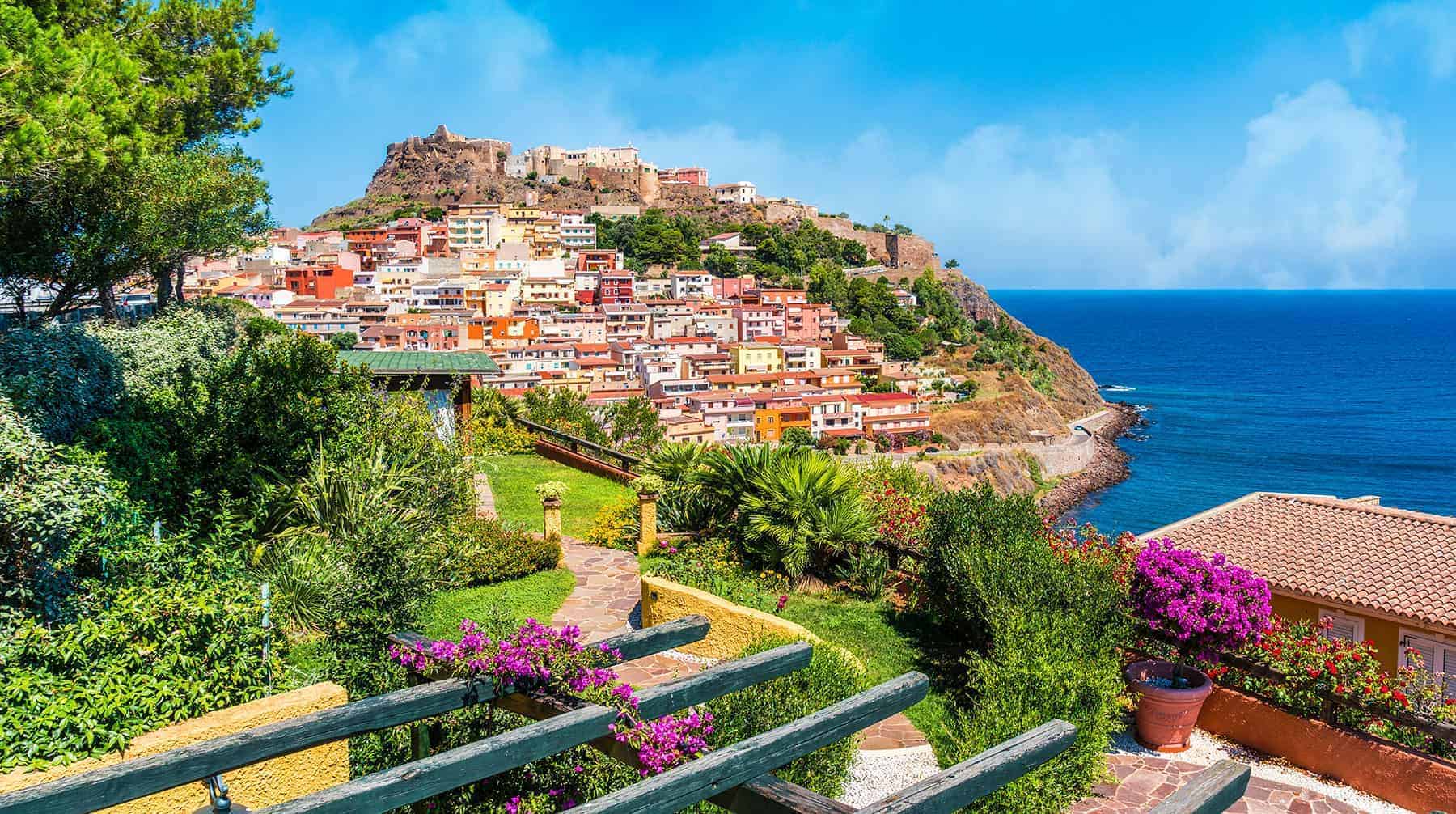
The winter can get chilly in Sassari, but never too cold, and for every day that you get rain or overcast skies, even in winter, you get about five times as many days with blue skies and sunshine.
If you love the outdoors, unspoiled and natural beauty, exploring, and new experiences, then you should definitely consider Sardinia as your retirement destination. For those who are after the most comfortable weather in Sardinia, Sassari is the place in which to settle down.
It’s the second largest city of Sardinia, located to the north of the island, and it is said to experience some of the most comfortable weather on the planet.
The average annual daily high temperature for Sassari is 19°C, and the mean annual daily low temperature is 11°C. In August, the warmest month, the temperature can occasionally reach 31°C, but the nights will stay at a pleasant 18°C. In winter, it gets colder but very rarely drops below 5°C.
Such a temperate climate is bliss for those who love the outdoors.
In the Province of Sassari, you can find some of Sardinia's most beautiful beaches, which makes it an ideal location if you want to live by the sea.
The nearby Asinara National Park provides residents with numerous opportunities for fantastic walks and excursions to explore the beauty of local flora and fauna and to personally get acquainted with famous albino donkeys, a symbol of the island.
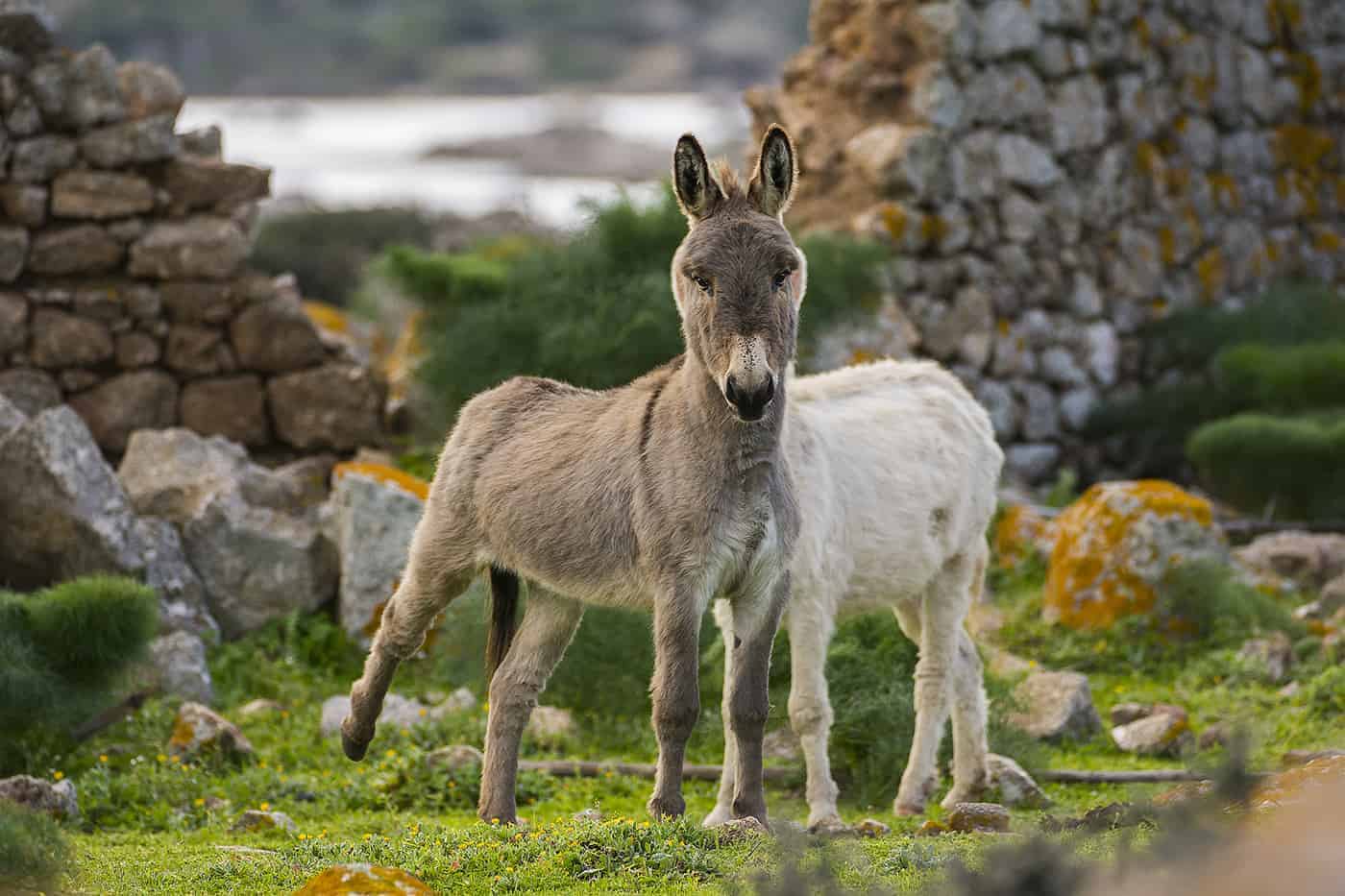
Another big advantage of Sassari and Sardinia, on the whole, is that the island is home to 10 foods that lengthen your life.
So when you combine the most pleasant climate, the stunning landscape that encourages people to go out and be active, and a very wholesome diet, the result is an amazing lifestyle that promotes a healthy mind in a healthy body.
Find out more in our guide on Living In Sardinia As An Expat
2. Madeira, Portugal
Madeira is proving to be a hotspot for retirees, mainly due to the weather and year-round good temperatures. The islands offer the kind of laid-back lifestyle that many people seek when they give up work.
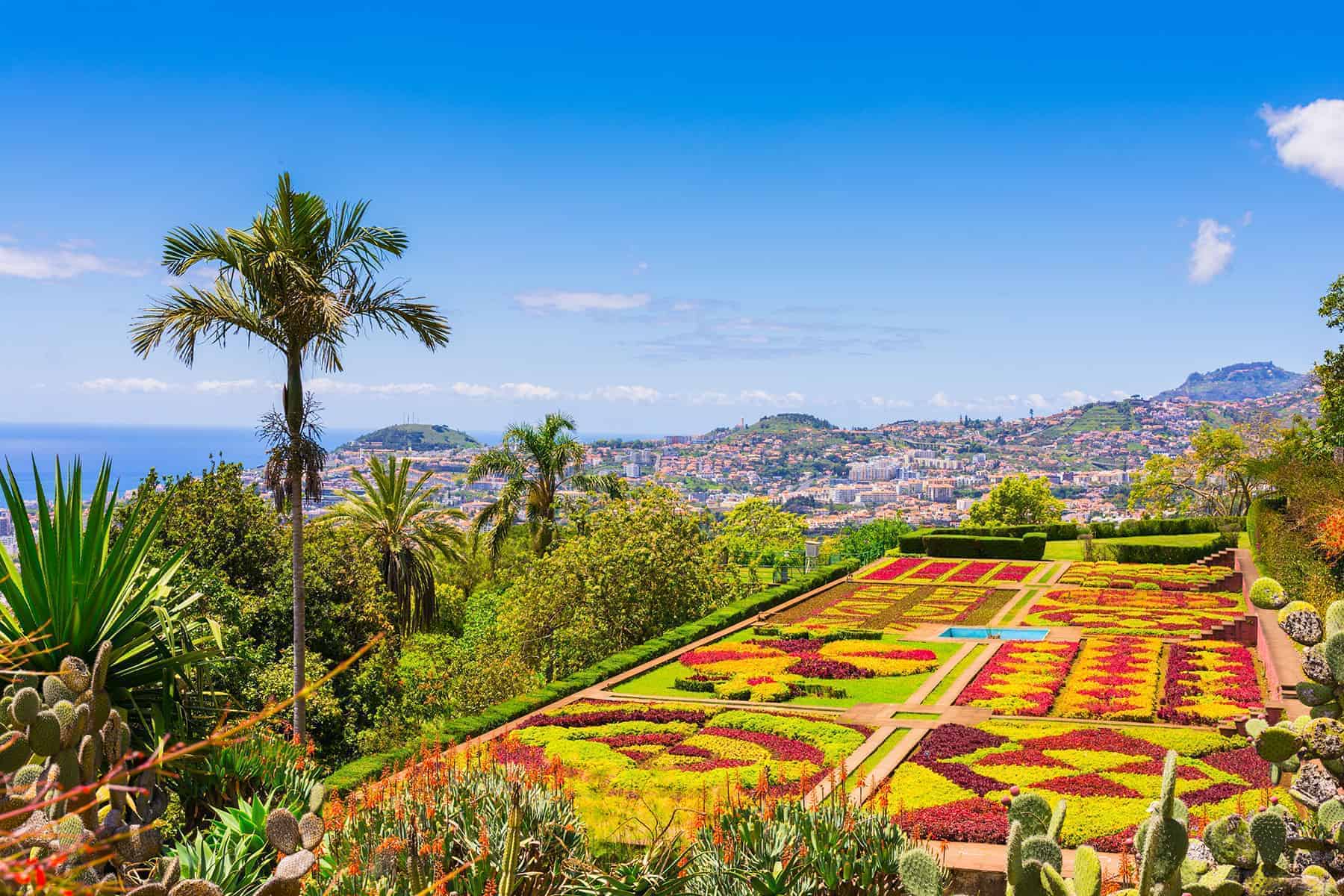
Most people who live in Madeira find that the island has just about the most perfect climate in the world — it only rains sometimes, and it is never too hot.
For this very reason retiring to Madeira is also very popular.
Being an island surrounded by the ocean, Madeira has no huge swings between the seasons, although they are still distinct. This explains why you will find flowers here at any time of the year.
With typical average temperatures ranging from 24°C in the summer to 18°C in the winter, it’s an island of eternal spring – a paradise for lovers of walks and gardening.
Madeira is a mountainous island and is full of diverse microclimates, which change not only from altitude to altitude but along the coast as well.
The higher up the mountains you live, the colder it can get, and what may be a balmy day on the coast can turn into a bracing day in the peaks.
If you are after stable temperatures all year round, it is below the ‘banana line’ where you should settle down.
The ’banana line’ in Madeira indicates the best altitude range - up to 200 meters above sea level - to cultivate bananas (and us foreigners), as it offers the warmest climate, especially in wintertime.
There are regional variations, too. The north-eastern prevailing wind makes the north of the island less sunny and wetter than the south.
The southwest is reputed to have the best weather of all: the capital city of Madeira, Funchal, and the towns and villages to the west of it along the coast are especially loved by expats.
The bay of Funchal, where Funchal City is located, takes full advantage of the highest peaks that protect it from weather extremes and so enjoys brilliant weather.
In ‘winter’ months, during the day in Funchal, it’s around 20°C, and at night it’s usually above 14°C. This is the ‘rainy’ season, but if it rains, usually it is only for a short part of the day, and then the sun comes out again.
During the summer months, temperatures reach a maximum of 24 °C and a minimum of 17 °C, so the nights are really pleasant, and it’s comfortably warm during the day. However, when the wind comes from the Sahara Desert, bringing hot air with it, temperatures can get up to around 33°C.
At such times of the year, the clouds are being pushed towards the mountains and can stay there over Funchal Bay for several days, forming a protective blanket over the city and softening the ambient temperature.
Thanks to these protective clouds or the Funchal helmet as they are known locally, even in the hottest month of August, Funchal stays relatively cool with an average temperature of 23°C.
As Madeira is an Atlantic island, storms are inevitable. They happen a number of times each year, bringing torrential rain and high winds.
Otherwise, the weather there is extremely pleasant, and the days often start clear. But because this is a mountainous island, cloud builds during the afternoon and then clears again at night.
Madeira is stunning. It is getting a bit busy, but it’s still affordable, and because of its fabulous climate, it is a brilliant location for an active lifestyle all year round.
You will find more information about expat life on this wonderful island in our Living in Madeira guide.
Read our Living In Portugal guide for tips on moving to Portugal, residency, healthcare, banking, low-tax living in Portugal, housing, etc.
3. Las Palmas, Gran Canaria, the Canary Islands
The type of island living pictured in glamorous travel ads and magazines, with sunny 25°C walks along the beach every day, does not always reflect the climate reality. Many officially ideal islands can get pretty hot in summer and downright depressive in a rainy winter season.

However, there is a big notable exception to this – Gran Canaria, one of the Canary Islands, especially its largest town Las Palmas.
The Canary Islands lie in the Atlantic Ocean just off the coast of southern Morocco and enjoy a remarkably mild climate. They are located just north of the Tropic, a short distance from Western Sahara.
The best bit about their location is that they are in a stretch of sea where a cool current flows; they are also subject to the trade winds, which blow constantly from the northeast and work as a sea breeze.
This means that even on the hottest days, the ambient temperature is quite pleasant.
The capital of Gran Canaria, Las Palmas, experiences one of the healthiest climates for humans on the planet, according to the Syracuse University study that declared Las Palmas’ climate the world’s most pleasant.
The study didn’t just count the number of sunny days a year. It also looked at various things like average temperature, lack of extreme weather events, and rainfall.
It’s one thing to have a holiday in perpetual direct heat and quite the other to live in it. So if you come to Las Palmas as a tourist, you might feel disappointed that the place seems a little bit cloudy half the day.
Las Palmas is cloudier than the resorts in south Gran Canaria and even Agaete in the northwest corner of the island.
Through the hot summer months, Las Palmas has a low-lying cloud called the donkey’s belly that lingers there until midday.
This is because the Trade Winds blow from the north and pile up clouds against the steep northeast coast. The result is that Las Palmas gets fewer sunshine hours than the rest of the island but is also sheltered from extreme temperatures.
When huge windstorms in North Africa lift tons of sand off the surface of the Sahara Desert and blast hot, dusty air out over the Atlantic Ocean and the Canary Islands, the temperatures can reach 47°C.
The islanders call it ‘calima’. It’s when the protective cloudy blanket over Las Palmas is most greatly appreciated.
It can be 43°C in south Gran Canaria during a calima, while in Las Palmas, it wouldn’t touch 30°C.
In winter, when the cloud-free southern skies leak heat, the temperature can drop to 14°C at night, while it’s rarely below 18°C in the capital.
The Trade Winds also blow away traffic fumes making Las Palmas the city with the cleanest air in Spain.
On the whole, Las Palmas is comfortably warm throughout the year. The annual daily mean temperature at Las Palmas is about 20-21°C, with an annual daily high of 24°C and an annual night-time average low of 18°C, according to the Spanish Meteorological Agency.
You will experience just five inches of rainfall in Las Palmas, on average, annually, with June through August having no rainfall whatsoever.
Despite being cloudier than the rest of the island, Las Palmas still has copious sunlight.
However, if you long for a baking session on a beach with no cloud in sight, just hop in the car or get a bus to the resorts or to Agaete, and you’ll be under the blue dome within 30 minutes.
Discover more in our guide Living In The Canary Islands: The Pros & Cons For Expats
For essential information for anyone considering moving to Spain: tips on planning your move, locations, cost of living, legalities, bank accounts & healthcare, etc., read Living in Spain – The Expat’s Essential Guide.
4. Liguria, Italy
A microclimate is a key to perfect weather.
Big areas with defined seasons can hide little pockets of paradise-like mild climate all year round. This is exactly the case with Liguria, Italy’s western coastline stretching to Monaco.
Liguria is the only Italian region to have the Alps, Apennines, and the sea all quite close together. It is also part of the Italian Riviera that stretches from France to Tuscany.
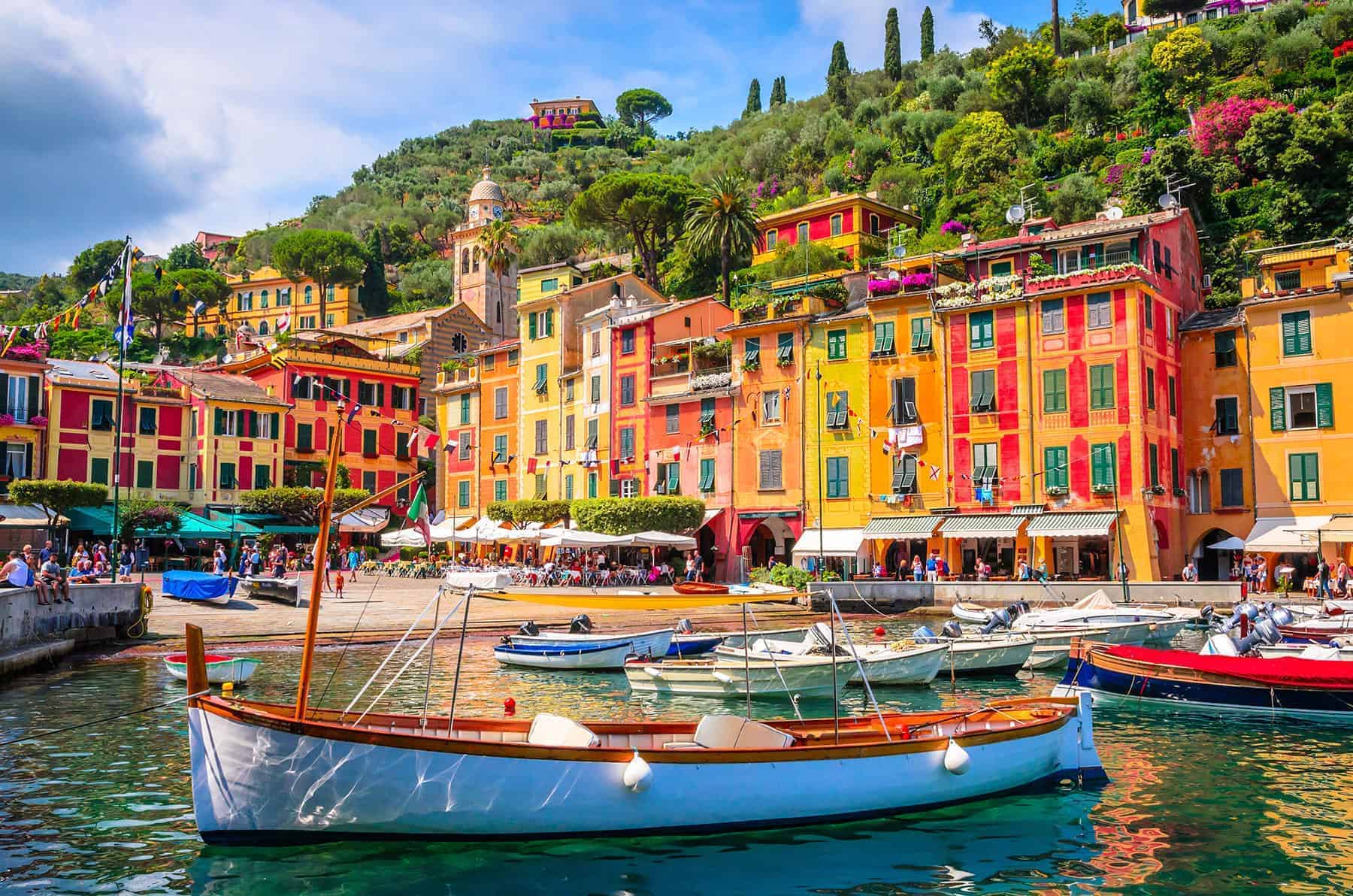
Liguria is walled by the mountains in the north and protected by the sea in the south. Add to the mix the gulf stream, and you have a recipe for a mild climate throughout the year. Other parts of Italy can have pretty wide annual temperature fluctuations, but not Liguria.
Liguria boasts 300 sunny days in the year and is one of the sunniest regions in Italy. The average winter temperatures are around 6-11°C, while the summer temperatures average around 25-28°C.
This means the weather in Liguria is pleasant even in the heart of winter. Of course, you wouldn’t plunge into the sea or lie on the beach in January. However, it’s quite possible to find a beautiful beach spot to sit down, take the dog for a walk, have a picnic, or simply enjoy great views and catch the winter sun.
This wonderful microclimate has resulted in a paradise-like environment for garden lovers - the floriculture is thriving there.
The especially picturesque part of Liguria, stretching from France to Diano Marina, is called the Riviera of Flowers (Riviera Dei Fiori).
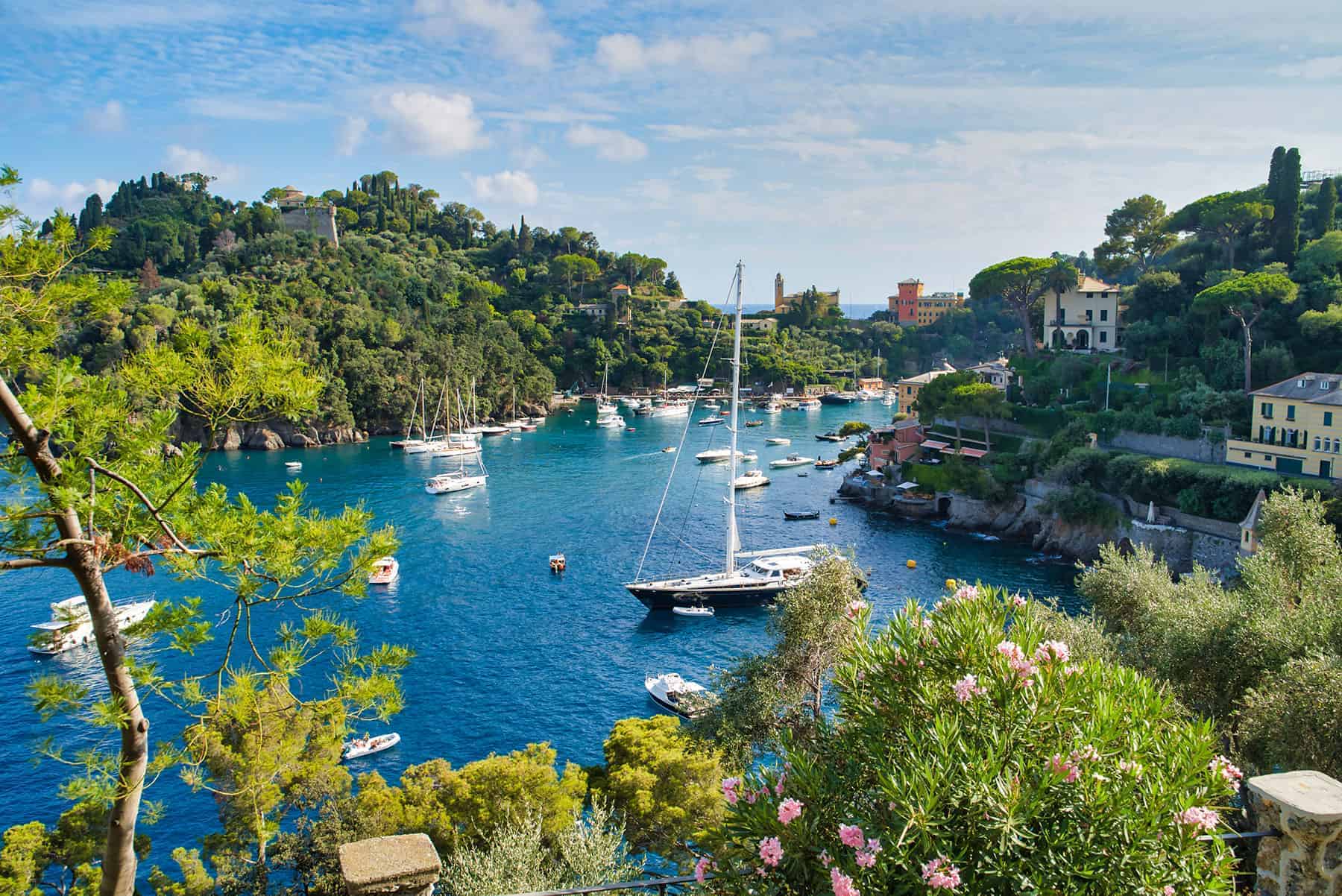
This part of the coastline is an explosion of brightly blooming flowers and trees. This all comes to a glorious culmination in San Remo - the City of Flowers. San Remo is famous for its lush, beautiful scenery. Everywhere you look, there are flowers, palm trees, and tropical vegetation.
Parks and gardens are bursting at the seams with all kinds of flower species from around the world. Roses, begonias, carnations, and other flowers are cultivated in the San Remo region. This is all thanks to the mild and protected microclimate of Liguria.
5. La Rochelle, France
France also has a few microclimate areas. One of them is the coastal port town of La Rochelle in Charente-Maritime.

La Rochelle will be a perfect match for you if you love sunlight but not excessive heat.
The whole region of Charente-Maritime is apparently the second sunniest place in France, and La Rochelle enjoys more sunshine during the year than some parts of the Côte d’Azur, although summer temperatures are milder.
Average temperatures in La Rochelle go from 5.8°C in January (the coldest) to 19.7°C in August (the hottest).
La Rochelle is not quite as warm or as glam as the towns and villages of the French Riviera.
However, the summers there are simply glorious. June, July, August, and September are the most pleasant months, with average temperatures falling between 20°C and 25°C. There’s not much rain and a lot of sunshine.
During the summer months, the days are long. The sun is above the horizon for sixteen hours. What can be more pleasant than sitting on your own terrace with a glass of wine facing the Atlantic and watching the sunset at 9.30 pm?
You won’t lack sunshine in La Rochelle. The region receives about 2,600 hours of sunshine per year.
La Rochelle is also known for sailing, beautiful beaches, cycling, a splendid fish market, a summer music festival, and simply for being a very pretty and livable place full of green spaces.
The charming Parc Charruyer stretches across the town all the way to the harbor. The park is narrow and long. Over 2 km of paths wind through the 40-hectare green space, and you can sprawl on the grass, enjoying the sun for most of the year.
The mild climate of La Rochelle is perfect if you love an active outdoor lifestyle. Hiking paths are plentiful, and the town itself is very cycle-friendly. It has a system of yellow bicycles called Yélo that offers affordable, sustainable transportation around the city.
For all those reasons, La Rochelle and the whole Charente-Maritime region are very popular with foreign retirees. The added bonus is three main airports within easy reach serviced by budget airlines that fly to many destinations abroad.
Moving to France? Our Living In France Guide includes day-to-day essentials like paperwork, doctors, bank accounts, utilities, and more important things like housing and residency.
Summary
These five places are not quite the ideal +23°C all-year-round paradise. However, they are the closest to it you can find in Europe.
Ironically, mild weather is also a main feature of Britain, especially if you live in the southwest of England or decide to move to Wales. What you might find lacking is sunshine.
The five locations we have found can provide you with mild weather and plenty of sunlight throughout the year so that you can stay happy, active, and healthy in your retirement.
You might find useful:
- The Best Places To Retire Abroad - If you’re thinking about where you can put your feet up in perpetual sunshine and luxury, here is the list of the best places to retire abroad.
- The Guide To EU Golden Visa Schemes For Non-EU Citizens - compare EU Golden Visa programs to find the one that suits you best.
- The Expat Guide To UK Pensions Abroad: Understand Your Options
- Visit our homepage for a comprehensive range of Living Abroad guides.
Helpful external links:
- The Health Benefits of a Warmer Climate - Stanford University
- 5 “Blue Zones” Where the World’s Healthiest People Live - National Geographic.
Secure Peace of Mind with Best-Value International Health Coverage
International Citizens Insurance provide free, no-obligation quotes from the leading international health insurance providers with plans tailored to meet your needs. Trusted by thousands of expats worldwide.




